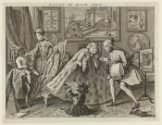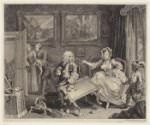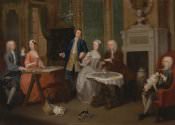Taste in High Life

W. Hogarth, Taste in High LifeWilliam Hogarth, Taste in High Life. Lewis Walpole Library, Yale University, 772.9.10.1, Kinnaird 74K(b) Box 115

W. Hogarth, A Harlot's Progress, Plate 2: Mary Hackabout distracts her patron's attention by kicking over the tea tableWilliam Hogarth, W. Hogarth, A Harlot's Progress, Plate 2: Mary Hackabout distracts her patron's attention by kicking over the tea table, 1732, etching with engraving. Lewis Walpole Library, Yale University, Sotheby 3++ Box 300.
Taste in High Life
May 1746 (published)
William Hogarth
1697-1764
Engraving on wove paper
21 x 28 cm
This print, which was engraved after a painting by Hogarth of the same title, is a savage satire of fashion among London’s upper classes. The two ladies and gentleman pictured here are arrayed in the latest styles, imported mainly from France: constricting corsets, voluminous hoop skirts, and high-heeled shoes. A monkey (a traditional symbol of servile imitation) reads from a French-inspired menu. The lady at left is depicted with an enslaved servant who wears an exoticizing feathered turban, pearl earring, and metal collar. Described by one eighteenth-century critic as a “miniature Othello,” he is shown holding a figurine of a Chinese mandarin, an item that reflects the contemporary rage for "chinoiserie”—a Western style that imitated patterns and motifs derived from Chinese art. As in Plate 2 of A Harlot’s Progress, the servant’s depiction here is intended by Hogarth to signal not only the wealth but also the material excesses and false pretentions of his owners.
Taste in High Life contains at least one disguised portrait. The gentleman represents Charles Colyear, second Earl of Portmore. The page has traditionally (but implausibly) been identified as Ignatius Sancho, whose portrait as a grown man appears in this exhibition.
Lewis Walpole Library, Yale University, 772.9.10.1, Kinnaird 74K(b) Box 115


